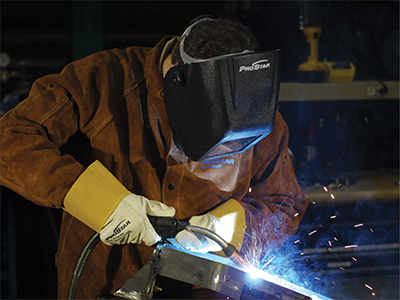Buyers Guide: 5 Considerations for Choosing a Welding Helmet
Welding helmets are crucial to welder safety and provide protection during welding and grinding applications. A number of styles are available on the market with wide-ranging features, but not all welding helmets are created equal. Selecting the right welding helmet will not only keep a welder safe and comfortable on the shop floor but also improve productivity and the quality of your welds. Here are some factors to consider when choosing a welding helmet.
1. Lens Type
The two types of available lenses are passive, which are normally made of a polycarbonate plastic, and auto-darkening, which are generally made of a liquid crystal display (LCD) glass. A passive helmet has a standard fixed-shade lens that remains
permanently dark. While these helmets are fairly inexpensive and lightweight, they also have a few disadvantages. 
Welding helmets featuring a fixed shade can be more difficult to use because a welder has to lift the helmet to inspect the weld, and then flip the helmet down when it’s time to strike the arc. This movement can cause neck strain and fatigue after a full day’s work. Additionally, in tight or restricted spaces, it can be difficult to maneuver the helmet. However, there are a few models in which the lens is in a flip-up assembly and allows the welder to flip up the lens, keeping the hood down and providing a clear window to see through.
Auto darkening helmets, on the other hand, change shades to fit the welder’s needs. When not welding, such as during fitup or grinding, sensors in the hood lighten the shade of the lens to a low, mostly transparent shade. These same sensors detect when the welder strikes the arc and darken the lens to a higher selected shade to provide the required protection.
2. Switching Speed
The switching speed matters a lot when looking for a helmet with an auto-darkening lens. Switching speed indicates how quickly the lens will change from its natural light shade to a darker shade for when you’re welding. The faster the lens switches, the more comfortable you’ll be. Entry level speeds start around 1/3,600 of a second, whereas the professional level is significantly faster at around 1/25,000 of a second.
3. Viewing Area Size
Welding helmets come with a multitude of viewing area sizes. A larger viewing area provides more visibility to the weld and the weld area, while a smaller viewing area provides a more focused view of the weld and weld area. When looking at a larger viewing area, the added weight of the helmet may be something to consider.
4. Helmet Weight and Comfort
Many welders wear helmets for several hours over the course of a day. A comfortable helmet increases productivity and reduces fatigue. If you’ll be welding for several hours at a time, a heavy-duty one could be uncomfortable or painful. Lighter helmets tend to cost more, but they reduce fatigue in the neck and shoulders.
For the best fit, be sure your helmet has appropriate padding and an adjustable headband, and don’t be afraid to try on helmets before you purchase one to ensure you get one that feels comfortable.
5. Number of Sensors
Helmets can also feature a range of sensor options. Entry level helmets typically have two sensors, whereas professional grade helmets usually have as many as four. For better responsiveness, more sensors are recommended, especially for out-of-position welding where a sensor may be obstructed.
Conclusion
The use of quality personal protective equipment and safe welding practices must be a top priority for welders, regardless of the type of welding process. Choosing the best helmet for your welding processes depends on many factors, and while it may be tempting to buy the least expensive helmet, taking the time to explore all of your options can be more beneficial for your safety and productivity. Contact your Linde at 1-800-225-8247, or visit your local Linde store to learn more.






























